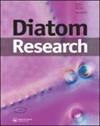Description of Gomphonella saldanensis sp. nov. (Bacillariophyceae) from hydromagnesite stromatolites in Salda Lake, Turkey
IF 1.3
3区 生物学
Q2 MARINE & FRESHWATER BIOLOGY
引用次数: 0
Abstract
Lake Salda has a unique environment due to the presence of hydromagnesite stromatolites. Samples collected from the stromatolites contained a new diatom species, Gomphonella saldanensis sp. nov., which is described based on light and scanning electron microscopy. The main character of the taxon is its linear-lanceolate outline with a rostrate headpole and narrowly rounded footpole. The striae are strongly radiate mid-valve, becoming parallel to slightly radiate towards the poles. Elliptical Fourier and Linear Discriminant analyses indicate that there are different shape forms within the same taxon. Based on LM observations, G. saldanensis is similar to Gomphonema lagerheimii f. simplex, G. geisslerae, Gomphonella calcarea, G. olivacea, G. acsiae and G. coxiae. However, G. lagerheimii f. simplex differs with slightly radiate striae throughout the valve. Gomphonella geisslerae has a slightly undulate raphe and linear apices. Larger specimens of G. acsiae are lanceolate, clavate in smaller specimens. The remaining Gomphonella species, G. calcarea, G. coxiae and G. olivacea have broader outlines and lower stria densities.土耳其萨尔达湖水藻叠层石中萨尔达鹅膏菌(Bacillarophyceae)的描述
萨尔达湖有一个独特的环境,因为水镁石叠层石的存在。从叠层石中采集的样品含有一种新的硅藻物种,即萨尔丹Gomphonella saldanensis sp.nov.,这是基于光学和扫描电子显微镜描述的。该分类单元的主要特征是其线状披针形的轮廓,具有喙状的头极和狭圆形的足极。纹强烈地向瓣中部辐射,变得平行而轻微地向两极辐射。椭圆傅立叶和线性判别分析表明,在同一分类单元中存在不同的形状形式。根据LM观察,萨尔丹鹅膏菌与普通鹅膏菌(Gomphonela lagerheimii f.simplex)、盖斯雷鹅膏菌、钙斑鹅膏菌和橄榄鹅膏菌相似。然而,G.lagerheiii f.simplex不同之处在于整个瓣膜有轻微的放射纹。艺妓蛾的中缝稍有起伏,顶端呈线状。艾的较大标本为披针形,较小标本为棒状。剩下的Gomphonella物种,G.calcarea、G.coxiae和G.olivacea具有更宽的轮廓和更低的条纹密度。
本文章由计算机程序翻译,如有差异,请以英文原文为准。
求助全文
约1分钟内获得全文
求助全文
来源期刊

Diatom Research
生物-海洋与淡水生物学
CiteScore
2.70
自引率
16.70%
发文量
27
审稿时长
>12 weeks
期刊介绍:
Diatom Research is the journal of the International Society for Diatom Research. The journal is published quarterly, in March, June, September and December, and welcomes manuscripts on any aspect of diatom biology.
In addition to full-length papers, short notes and reviews of recent literature are published which need not contain all the sections required for full-length papers; we see these as being necessary to record information which is of interest but which cannot be followed up in detail. Discursive “Opinion” papers are encouraged which would not necessarily follow the normal lay-out. If extremely long papers are to be offered, the author(s) should contact the editors first to discuss any problems. Book reviews, obituaries and meeting reports can be published. All papers will be subject to critical review by the editors and referees, as appropriate to their content. Papers will be accepted in English only.
 求助内容:
求助内容: 应助结果提醒方式:
应助结果提醒方式:


